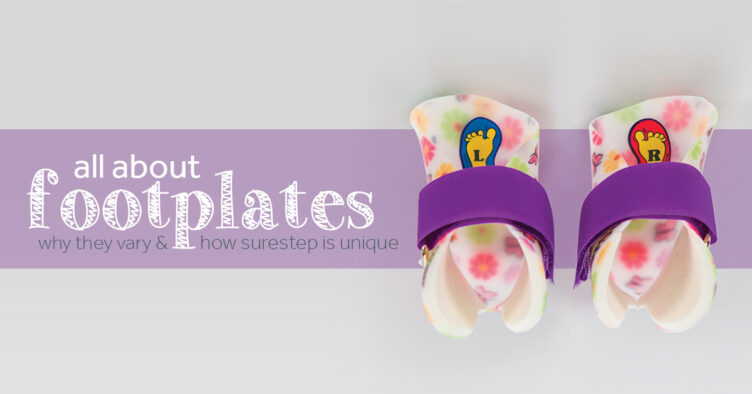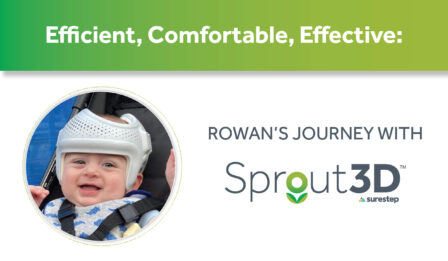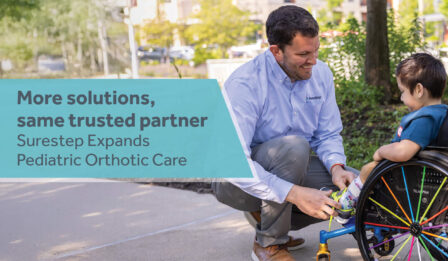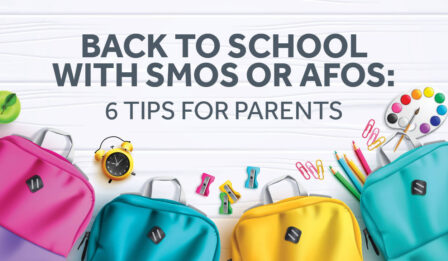all about footplates (why they vary & how surestep is unique)

Parents post pictures of their child’s braces on social media for both support and advice. One of the most frequent questions is about footplates. Why are some short? Why are some really long? What is the best length that makes putting shoes on easier?
The length and function of footplates vary from child to child, but they’re all integral to brace design because footplates can impact:
- how your child develops his or her adult walking pattern
- how your child improves strength in feet and legs
- how stable your child is while walking and standing
- how the brace helps the position of the foot
If fitting a child with an AFO or SMO with a full footplate, orthotists often leave an extra ¼” to 3/8” past the end of the toes to allow for growth. This is usually marked when the child is standing on the braces or the while the toes are pressed firmly down on the footplate. Leaving more than this would interfere with walking and will make it especially difficult to find shoes to wear over the braces.
In AFOs or SMOs using a Surestep footplate, the orthotist should not leave extra room for growth in the length of the footplate because this will interfere with developing a more typical pattern of walking.
The best way to talk about footplates is to separate the discussion into three categories:
Pronation & Hypotonia
Surestep introduced the Surestep SMO in 2000. Its unique design includes a shorter footplate. Before this, AFOs and SMOs traditionally had a full footplate that extended out beyond the child’s toes. On the Surestep SMO, the footplates are cut shorter on the inside of the foot and in front of the ball of the foot. On the outside of the foot it extends to the beginning of the pinky toe.
The Surestep SMO footplate is designed to control the hypermobile, pronated foot while still allowing the foot muscles and balance mechanisms to develop more typically. Within the first 6-12 months of walking, a child will usually transition from a walking pattern that consists of a foot flat position to a more dynamic and active foot as the body weight begins to move across the foot from the heel to the forefoot. This is called a heel-toe pattern of walking. It is the most stable way of walking and helps the leg muscles get stronger. Balance and coordination also improve as the child gets older. The Surestep SMO footplate is designed to allow this heel-toe pattern of walking in the child with low muscle tone and pronation.
Toe Walking
This is where a child adopts a walking pattern that has the foot’s first contact with the floor through the forefoot and/or toes. In many cases, this is the only place the foot contacts the floor. In another type of toe walking, the forefoot will hit the ground first and then the body weight moves backwards along the foot to the heel. This is most frequently seen when the child doesn’t have enough range of motion at the ankle. In the third most common type of toe walking, the child may hit with the heel or midfoot first, but then quickly moves to the forefoot for increased stability or a stronger sensory cue.
Orthotists have traditionally used full length footplates in children who toe walk. But Surestep researchers have discovered a full footplate isn’t always necessary to address toe walking. Sometimes a Surestep SMO, Surestep Toe Walking SMO, or Surestep Pull-Over AFO can improve toe walking using the standard Surestep footplate. By using the Surestep design on the footplate, the child can develop a more typical way of walking and improve strength in the foot and leg while preventing toe walking.
Crouch Gait & Standing Stability
Crouch gait is when the child seems to flex forward at the hips and knees into a crouch while they are walking. This is most frequently seen in children with cerebral palsy. It is generally caused by a combination of weakness in the leg, hip and trunk muscles, spasticity and a lack of range of motion at the hip, knee or ankle.
In order to improve crouching and also improve stability for a child using the braces in a standing frame or gait trainer, the orthotist may use a full footplate with the sides of the brace extending to the ends of the foot as well. This creates a very stiff footplate to reduce the tendency of the body weight to roll over the foot and allowing the shin to move forwards too far. In many children, this can improve their walking, but the success of the crouch gait AFO also depends on the alignment of the foot/ankle inside the brace and continued work strengthening the muscles at the hips and trunk.
In some cases, a child may have one foot longer than the opposite foot or may have very short feet compared to their height. In these cases, an orthotist may extend the footplate well past the toes to create a more normal length foot. This improves stability during walking.
If you have questions about the length of your child’s footplate, always contact your orthotist and ask them to take a second look if you think they are too long or too short.
Which Surestep product is right for your child?



